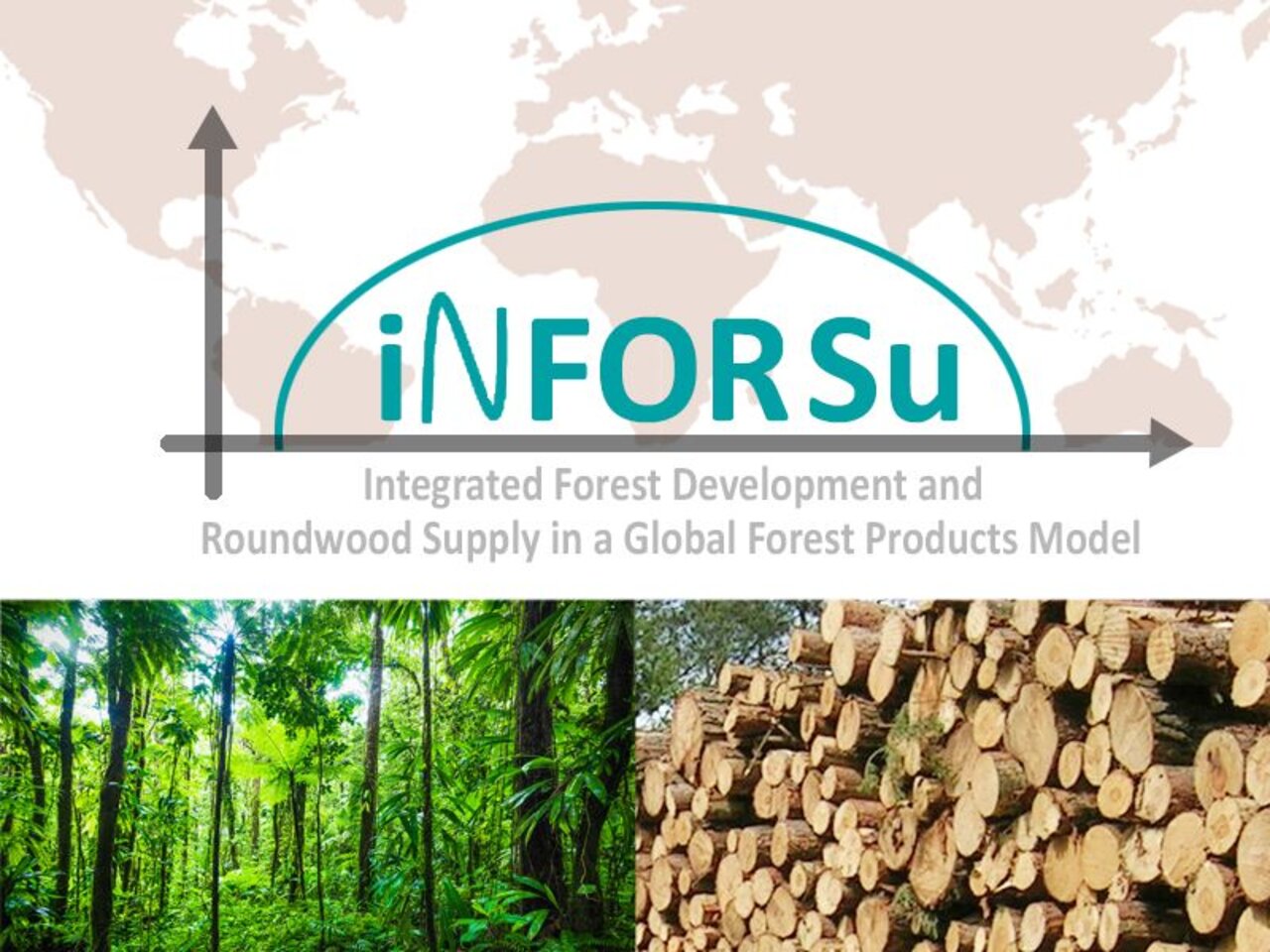Project
Modelling of the global roundwood supply

Which economic theories describe the relationship between socioeconomic variables and forest development? How can global roundwood production be modeled with the help of theories of forest development? We want to improve the global forest products model GFPM with an extension of the module on forest development.
Background and Objective
The economic partial equilibrium model "Global Forest Products Model" (GFPM) simulates production, trade and calculated consumption for roundwood, semi-finished and finished products for 180 countries. This includes sawn wood, wood-based materials, pulpwood, paper, fibreboard and recovered paper. Market equilibrium calculations are based on developments in supply and demand, as well as manufacturing and transportation costs. The supply of roundwood is determined by the growth dynamics of forest stock, the change in forest area and the harvest volume. For the estimation of the supply-side roundwood production, a forest-specific module is integrated in the GFPM, which uses forestry and socioeconomic variables for the simulation. In addition to forest-specific parameters, the development of the gross domestic product (GDP) per capita is an important basis for this. The GFPM currently uses the theoretical approach of the Environmental Kuznets Curve to link forest development to economic factors.
The objective of our research project is to improve the representation of the roundwood supply in the GFPM by a more precise depiction of the total forest development under consideration of socioeconomic variables.
Target Group
Politics, Society, and Science
Approach
In this project we bundle several research activities. The focus of the work is the further development of the dynamic, price endogenous partial equilibrium model.
In a first step, the integrated model for the simulation of forest development is referenced to the current scientific state of the art by means of a systematic literature analysis. The aim here is to contrast the relevant theoretical approaches to forest development and compare them with respect to their socioeconomic variables. Special emphasis is also put on a possible differentiation of different forest types. Based on this, the adaptation of the supply-side simulation in GFPM takes place. For this purpose, the basic structure of the forest-specific model part must be reframed in GFPM in order to make necessary adjustments and extensions in the module for the simulation of forest development.
Our Research Questions
Our research questions regarding the analysis of forest area development are as follows:
- What are the most significant drivers of forest area development under the Environmental Kuznets Curve for deforestation and the Forest Transition Hypothesis?
- How does the differentiation of forest area types, as well as the consideration of various socio-economic variables, affect forest area estimation?
- What are the impacts of an improved estimation on forest area development?
Results
Understanding forest area dynamics as a function of socio-economic dynamics is critical to halt deforestation and forest degradation and to shape future policy recommendations. Two prominent concepts used to analyze forest area dynamics in relation to socio-economic development are the Forest Transition Hypothesis (FTH) and the Environmental Kuznets Curve for deforestation (EKCd).
In the literature, a multitude of articles have been published in the last 30 years on the numerical estimation of the relationship between socio-economic factors and forest area development. To learn from these studies, which differ in terms of model specification, region, variable selection, and statistical methods, a comprehensive systematic literature review of the current state of research is a result of the first work package. Among the 46 included publications, the evidence base for the EKCd is more comprehensive than for the FTH, and the majority of selected studies focus on data from developing countries. The analysis of statistical estimates does not provide a consistent picture but rather a variety of interpretations and specifications. The conclusions of the analyzed articles suggest that future studies should expand the study design by addressing relevant variables of research and policy interest. A deeper analysis of the different approaches to interpreting the two concepts presents the further results of this project step. The project results of the first work package are published as a peer-reviewed article.
In addition to updating and supplementing the selected studies, the second work package investigates the determinants of the EKCd and FTH concepts. To identify patterns from heterogeneous studies, they are synthesized with regard to their model specifications. Variables related to economic income, derived from gross domestic product (e.g., income per capita, income growth per year, and total income of an economy), are most frequently tested and show a significant impact on forest development in approximately 70% of the studies. In all the studies examined, we find over 150 different independent variables that describe forest dynamics. These variables differ in terminology; however, they can be assigned to 12 groups of content (in addition to economic income, these include demographic factors, trade factors, factors that directly describe land area development, and institutional factors). Research gaps are evident in the examination of industrialized countries, which are only partially described by the two concepts of EKCd and FTH, as well as in the differentiated consideration of forest area types. In the further course of the project, we aim to fill these research gaps and expand the theories with regard to naturally regenerated forest area ("primary forest") as well as planted forest areas and plantations according to the definition of the Global Forest Resources Assessment 2020.
Thünen-Contact

Involved Thünen-Partners
Duration
9.2020 - 2.2025
More Information
Project status:
finished
List of Publications
- 0
Tandetzki J, Morland C, Schier F (2025) Beyond the forest transition hypothesis : Uncovering the drivers influencing natural, planted and plantation forest area development using regression-based machine learning approaches. Land Use Pol 158:107762, DOI:10.1016/j.landusepol.2025.107762
- 1
TI-FSM, Morland C, Schier F, Tandetzki J, Honkomp T (2025) TiMBA (Timber market Model for policy-Based Analysis). J Open Source Software 10(115):8034, DOI:10.21105/joss.08034
- 2
Tandetzki J, Köthke M, Schier F, Weimar H (2024) A systematic review of forest area development drivers estimated under the concepts of environmental Kuznets curve and forest transition hypothesis. Environ Res Lett 19(4):043001, DOI:10.1088/1748-9326/ad2e70
- 3
Tandetzki J, Schier F, Köthke M, Weimar H (2022) An evidence and gap map of the environmental Kuznets curve and the forest transition hypothesis for estimating forest area development. Environ Res Lett 17(12):123005, DOI:10.1088/1748-9326/aca781








